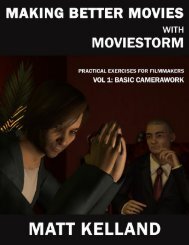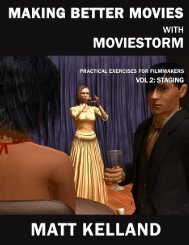Making Better Movies with Moviestorm Vol 3: Sound and Light
Making Better Movies with Moviestorm Vol 3: Sound and Light
Making Better Movies with Moviestorm Vol 3: Sound and Light
You also want an ePaper? Increase the reach of your titles
YUMPU automatically turns print PDFs into web optimized ePapers that Google loves.
DAY VS NIGHT<br />
Technique<br />
Make a music video.<br />
Night shoots often require different staging as well as different lighting. It’s not always as simple as just making it<br />
dark. You need to create an artificial lighting setup that allows the viewer to see what you want them to see, but<br />
making it feel like darkness.<br />
Left: a scene shot in daylight. Center: dropping the light level gives an image that's dull <strong>and</strong> hard to make out.<br />
Right: adding in a couple of front lights <strong>and</strong> adding depth of field allows the characters to st<strong>and</strong> out from the<br />
background, creating a clearer image.<br />
Left: an even darker version of the previous shot focuses the viewer completely on the characters by effectively<br />
taking away the background. Center: a reverse <strong>with</strong> this lighting setup means you can't see the man's face, as<br />
the lights are set up to light the woman. Right: reset the lights so you can see his face in this shot. The viewer<br />
probably won't notice the lack on lighting continuity if they're focused on the story. (See the earlier exercise on<br />
lighting continuity)<br />
Use a scene in a single location – preferably exterior. Ideally, it should be 1-2<br />
minutes long, including 2 or more people. You can use either an action or a<br />
dialog scene, as they will give you different challenges.<br />
33




